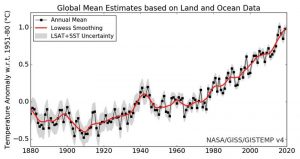
Image © NASA
Wind
Hurricanes are growing stronger, and tornadoes are increasing in frequency.
Temperatures
Both land and ocean temperature measurements from the National Aeronautics and Space Administration (NASA) over the past 140 years indicate the global annual mean surface air temperature is increasing.
This data has led to revisions in the requirements for the construction industry. For example, the American Society of Heating, Refrigeration and Air-conditioning Engineers (ASHRAE) recently revised the Climate Zone classification for many counties in the United States. Every revision was to a lower climate zone, indicating the climate is getting warmer in the affected counties.
Hail
The National Oceanic and Atmospheric Administration (NOAA) reported on the increase in medium and large hail events from the early 1950s to 2003. Analysis of this data shows a significant increase in reports of hail greater than 25 mm (1 in.) in the last 20 years of that study.
The requirements for the use of highly impact-resistant roof systems continue to expand in scope and coverage. Factory Mutual (FM) Approvals provides product testing and certification programs for the roofing industry, and has established many industry-recognized testing standards.
FM Global also develops and offers to the industry its Loss Prevention Data Sheets (LPDS) that provide engineering guidelines for many types of roof systems and materials. The most recent version of FM LPDS 1-34, “Hail Damage,” includes a hail-zone map which has a Very Severe Hail (VSH) zone affecting 14 states. The VSH zone first appeared in 2014, and was updated in 2018.
Together, the increasing reports of hail events across the United States present important evidence that impact resistance will play a growing role in the need for more resilient building designs.
Resilience in roof design
Resilient roof systems are designed to be more durable structures that can weather storms and other potential hazards. Two most important characteristics of a resilient roof system include wind and impact resistance.
Wind resistance
Determining the wind loads affecting a roof system is based on requirements contained in the International Building Code (IBC) and the American Society of Civil Engineers (ASCE) 7, Minimum Design Loads and Associated Criteria for Buildings and Other Structures.
Wind mapping tools help select a location-based wind speed that is used to determine the loads that are acting on the roof system.
While recent building codes have become more stringent in determining design wind loads for roof systems, the requirements are based on historical data that has been collected over decades.
Considering current climate trends, designing for higher-than-code wind speeds (e.g. +10, +15 mph) will increase the design loads acting on the roof, and subsequently, a roof system with higher capacity will be selected for use. This provides better than code-minimum protection against roof blow-offs and other wind-related failures.
Variables, such as the local building code and building dimensions, use, occupancy, exposure, and type, are also used to determine loads acting on a roofing system.
The building code enforced at the project location determines which version of ASCE 7 is required. Not all locations have adopted the most recent codes, and therefore, the use of the most recent version of ASCE 7 might be recommended, but not be required. Determining wind loads using the most recent version of ASCE 7 is best practice for longer-term sustainability as climate change continues.
Specifying a higher wind exposure category also increases loads. There are three exposure categories: B, C, and D. Selecting a higher category is a more risk-averse selection.




